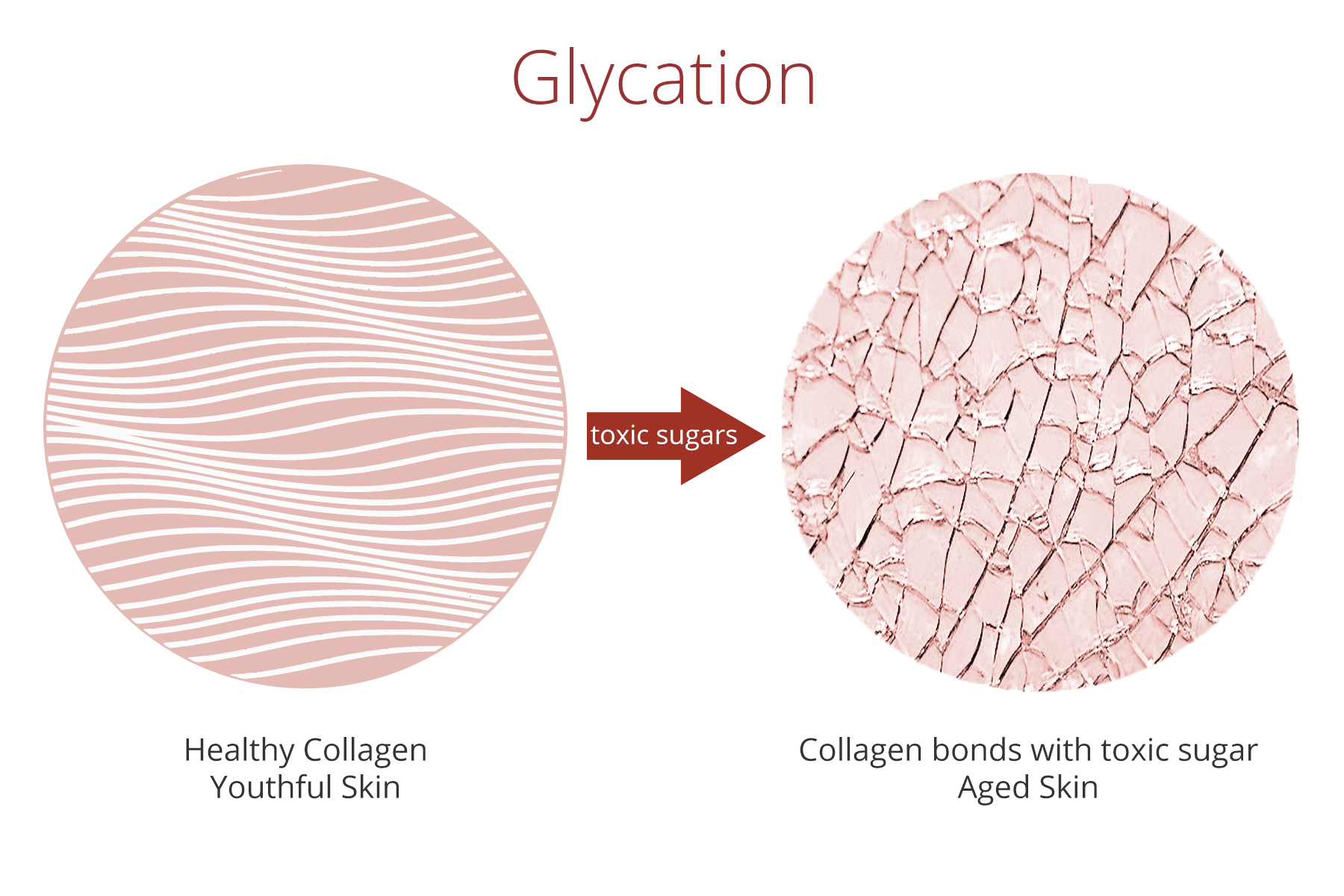Why Sugar is Responsible for Aging Skin
 Have you been noticing a few extra wrinkles, some deep lines or sagging in your skin? Sugar may be one of the culprits. Yes, sugar gives us that momentary rush of heaven, that temporary hit to our taste buds and who can resist that decadent dessert presented so beautifully, yet all the while feeling a twinge of guilt with that potential of more jiggle in our middle.
Have you been noticing a few extra wrinkles, some deep lines or sagging in your skin? Sugar may be one of the culprits. Yes, sugar gives us that momentary rush of heaven, that temporary hit to our taste buds and who can resist that decadent dessert presented so beautifully, yet all the while feeling a twinge of guilt with that potential of more jiggle in our middle.
…But whose worrying that the decadent dessert will cause wrinkles and even sagging skin. Not many.
Sugar, in all its forms whether natural or processed (corn syrup, agave syrup, honey, cane sugar, high-fructose corn syrup, etc.) promotes not only inflammation, a depressed immune system, but damage to the skin and to our internal tissues or organs as well. This is the result of a chemical reaction in the body called glycation. The majority of people have an excess sugar intake and excess sugars initiate glycation at an increased rate.
The human body depends on sugar and oxygen to provide the energy. The mitochondria powers up every cell in our body using glucose, fatty acids, and oxygen. But it comes with a price…
When you cut an apple and wait, what happens? That brown color begins to appear….. a result of oxidation. We’ve all seen the crispy browned potatoes, a roast chicken, toast, the charred grilled steak or the crispy fried chicken, that crispiness is glycation or caramelization (browning). When proteins and sugars attach, glycation occurs and this same process happens to the tissue in the human body as well – the caramelization of our bodily tissues. Eating foods with high sugar content or that have been processed with high heat (like deep-frying) means you’re ingesting another form of glycation – Advanced Glycation End Products or AGEs (as is so aptly named) directly.
Think of your cells as engines running on fuel, with much exhaust. Well-tuned engines run clean. When our cells are operating healthfully, they burn energy efficiently Not-so-well-tuned engines produce thick, black smoke. Similarly, unhealthy cells operating inefficiently produce more exhaust, and acid. Toxic residue then begins to accumulate in and around the unhealthy cells. This degrades our cellular health and the engines that run our cells; our mitochondria. Our mitochondria are key to our optimal health. Sugar is the most damaging compound to mitochondria.
As glycation progresses, this leads to mitochondrial energy production that slows down, along with increased oxidative stress. Eventually, damaged mitochondria can stop functioning, accelerating the aging process both inside and outside the body.
Glycation takes its toll slowly. It gums up your proteins, deactivates your enzymes, triggers unhealthy, cellular signaling and damages your DNA = AGEing you.
The two tissues in our skin that make us look so youthful and springy are elastin and collagen. The worst part? They are the very proteins that attach to the sugar in our body creating glycation – attacking these two proteins which become discolored, weak and hardened and eventually we see wrinkles, sagging skin and a loss of radiance. But remember, this is not just happening with the tissues on the outside of our body….more importantly, it is also affecting the tissues on the inside of our body as well contributing to diseases such as heart disease, cataracts or cancer and kidney health.
Glycation is a natural process in the human body because most everything that we eat converts to glucose – even veggies! However, concentrated types of sugar ingestion speeds up the process and has a more powerful, robust glycating effect.

The good news? Glycation can be powerfully slowed. Choosing an anti-inflammatory lifestyle will take you to more youthful skin and optimized health:
Avoid Added Sugar in All Forms.
Avoid Excess Carbohydrate Intake. Such as whole wheat bread, white potatoes, white rice, pasta, and all grains. Excess healthy carbs are also a contributor to glycation.
Avoid High Temperature Cooking (think crispy, blackened foods). Steaming, stewing and poaching are the cooking methods rather than frying, direct-fire grilling and high-temperature roasting.
Add Antioxidant Rich Foods: Make every plate and anti-inflammatory meal. Choose all veggies, nuts, seeds, low-sugar fruits such as raspberries, blackberries, kiwi, healthy fats such as avocados, macadamia nut oil, and healthy proteins such as whole pastured eggs,

Add Targeted Supplements to Prevent Glycation and AGEs:
Carnosine. Carnosine helps prevent cellular glycation. This nutrient is a potent free-radical scavenger and anti-glycating agent that inhibits AGEs formation and its cross-linked proteins. Take carnosine with fat for bio-availability.
Benfotiamine. This nutrient (a lipid-soluble form of thiamine, vitamin B1) can boost your body’s cellular levels of vitamin B1, which is an essential component in clearing the dangerous debris left behind due to glycation.
Curcumin. Curcumin is the active component in the spice turmeric. Curcumin is an antioxidant, powerful anti-inflammatory, antimicrobrial, anticancer, memory-enhancing, life-extending, and Curcumin uniquely protects against AGE-induced diabetic complications.
Tomato Paste. Research shows that simple tomato paste strongly inhibited the formation of AGEs in the glycation process.
Resveratrol. Resveratrol has the ability to reduce oxidative stress along with its highly protective cellular effect.
Rosemary. The use of the herb rosemary will help reduce the formation of AGEs.
Alpha Lipoic Acid. Alpha Lipoic Acid possesses unique properties that specifically slow mitochondrial dysfunction and reversing mitochondrial damage by preventing the release of damaging oxidants.
Taking action will prevent and improve aging skin creating healthier, more youthful skin and in general significantly help reduce aging.
References
https://www.ncbi.nlm.nih.gov/pmc/articles/PMC3583887/
Thorpe SR, Baynes JW. Role of the Maillard reaction in diabetes mellitus and diseases of aging. Drugs Aging. 1996 Aug;9(2):69-77.
Li Q, Chen AH, Song XD, et al. Analysis of glucose levels and the risk for coronary heart disease in elderly patients in Guangzhou Haizhu district. Nan Fang Yi Ke Da Xue Xue Bao. 2010 Jun;30(6):1275-8.
Van Boekel MA. The role of glycation in aging and diabetes mellitus. Mol Biol Rep. 1991 May;15(2):57-64.
Sztanke K, Pasternak K. The Maillard reaction and its consequences for a living body. Ann Univ Mariae Curie Sklodowska Med. 2003;58(2):159-62.
Berrone E, Beltramo E, Solimine C, Ape AU, Porta M. Regulation of intracellular glucose and polyol pathway by thiamine and benfotiamine in vascular cells cultured in high glucose. J Biol Chem. 2006 Apr 7;281(14):9307-13.
Kiho et al. Tomato paste fraction inhibiting the formation of advanced glycation end-products. Biosci Biotechnol Biochem 68:200-5 (2004).
Jain et al. Effect of curcumin on protein glycosylation, lipid peroxidation, and oxygen radical generation in human red blood cells exposed to high glucose levels. Free Rad Biol Med 41:92-6 (2006).
https://www.ncbi.nlm.nih.gov/pubmed/27596404
Liu J. The effects and mechanisms of mitochondrial nutrient alpha-lipoic acid on improving age-associated mitochondrial and cognitive dysfunction: an overview. Neurochem Res. 2008 Jan;33(1):194-203.
©2018 DLS HealthWorks, LLC. Lori Shemek, PhD health and weight loss expert. Bestselling author of How To Fight FATflammation! and the bestselling author of ‘Fire-Up Your Fat Burn!’





